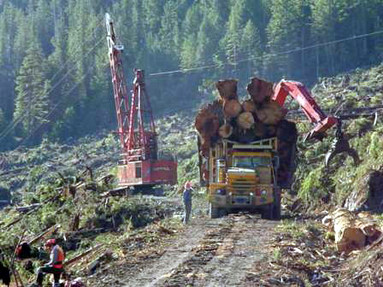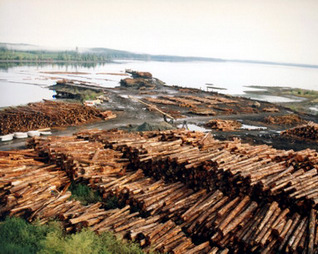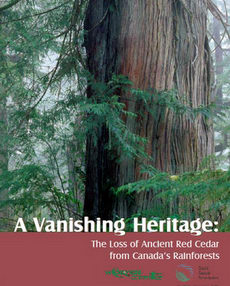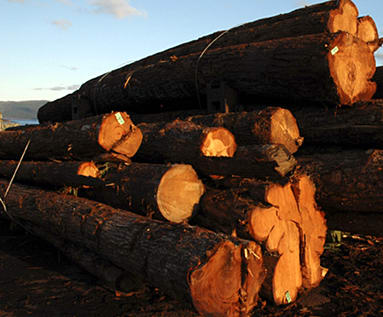| |
|
|
|
|
| |
Big Trees & Totem Poles |
|
|
|
| |
|
|
|
|
| |
Aboriginal
Heritage Trees |
|
Haida Gwaii Totem Poles |
|
| |
Skeena River Totem Poles |
|
The Vanishing of Totem Trees |
|
| |
|
|
|
|
| |
|
|
| |
|
|
|
|
| |
The Vanishing of Totem Trees
Voracious clearcut logging in British Columbia (BC) has resulted in the near extermination of totem trees, of monumental red cedars and other aboriginal heritage trees. Already two thirds of the ancient forests of Haida Gwaii have been clearcut logged. In 2004, the Council of the Haida Nation won a Supreme Court of Canada case against Weyerhaeuser, following which the American logging company abandoned its operations on Haida Gwaii. In March 2005, to protest the $1.2 billion sale of timber and real estate assets from Weyerhaeuser to Brascan, Haida and non Haida activists blockaded public roads on Haida Gwaii, preventing access to Weyerhaeuser and to the BC Forest Service. Haida Jaalen Edenshaw stapled "Seized" notices on the cedar logs in Weyerhaeuser's depot (right). |
|

Weyerhaeuser logs, Haida Gwaii, 2005
Photo: Simon Davis |
|
| |
|
|
 |
|
| |
The unregulated and relentless clearcutting over the past century in BC has resulted in the near annihalation of ancient red cedars (above) and other big trees. Already two thirds of the ancient forests of Haida Gwaii have been clearcut logged. In March 2005, to protest the $1.2 billion sale of timber and real estate assets from Weyerhaeuser to Brascan, Haida and non Haida activists blockaded two public roads on Haida Gwaii, preventing access to Weyerhaeuser and the BC Forest Service. See the Haida Gwaii Info. Centre archives: Islands Spirit Rising. Jaalen Edenshaw (above right) stapled "Seized" notices on the ancient cedar logs in Weyerhaeuser's depot (right). |
|
"SEIZED for breach of contract"
Photo: Council of the Haida Nation |
|
| |
|
|
|
|
| |

Deforestation of Haida Gwaii
Photo: BC Ministry of Forests, 2009 |
|

Deforestation of Haida Gwali
Photo: BC Ministry of Forests, 2009 |
|
| |
|
|
 |
|
| |
In 2007 the Canadian Geographic published a story on the
Haida efforts to protect their monumental cedars as part of their cultural heritage. See:
Keepers of the
Forest. Three galleries of photos illustrate the story: Cedar, Scenic and Totems. Haida forest guardian Jaalen Earnshaw is pictured as "truckloads of timber roll down the road" (right).
In 2004, the Council of the Haida Nation won a Supreme Court of Canada legal case against Weyerhaeuser, following which the American logging company abandoned its operations on Haida Gwaii. Today the Haida are working towards a controlling interest over the management of their forests which will include protecting the surviving ancient cedars as aboriginal heritage trees for future generations. |
|

Jaalen Earnshaw, 2007
Photo: Farah Nosh |
|
| |
|
|
|
|
| |

Islands Spirit Rising Blockade, 2005
Photo: Council of the Haida Nation |
|
A 1,000 year plan for managing cedarhas been proposed by the Council of the Haida Nation: "Haida Laas – Cedar Edition." Among those participating in the 2005 Islands Spirit Rising Blockade on Haida Gwaii were many Haida elders, including 92 year old Chief Niiswes (Ernie Wilson) dressed in ceremonial robe (right). Standing beside him on the right is the current Chief Skidegate (Clarence Collinson).
Chief Niiswes is carrying a protest sign with the Haida quotation: "People are like trees, and groups of people are like the forests. While the forests are composed of many different kinds of trees, these trees intertwine their roots so bly that it is impossible for the best winds which blow on our islands to uproot the forest, for each tree strengthens its neighbour, and their roots are inextricably intertwined. . . " |
|
| |
|
|
 |
|
| |
"In the same way the people of our Islands, composed of members of nations and races from all over the world, are beginning to intertwine their roots so ably that no troubles will affect them. Just as one tree standing alone would soon be destroyed by the first b wind which came along, so it is impossible for any person, any family, or any community to stand alone against the troubles of this world" Chief Skidegate, 1966, Gwaii Trust Society.
"I want to stress that it's the land that helps us maintain our culture. It is an important part of our culture. Without that land, I fear very much for the future of the Haida Nation . . . I don't want my children to inherit stumps . . . I fear that if we take that land, we may lose the dignity and the pride of being a Haida" Haida elder Florence Davidson.
John Broadhead sums up the loss due to industrial logging: "Thousands of logs worth millions of dollars have been seized by the Council of the Haida Nation for breach of contract because Weyerhaeuser has refused to abide by a written agreement to curtail the use of job killing mechanical harvesters and to safeguard cedar for Haida cultural uses. . . In the past 50 years, the industry has shipped away 80 million cubic metres of raw logs worth over $10 billion, plus $800 million in provincial stumpage revenues collected, and then many billions more in capital gains, reinvestment and multiple taxation benefits"
Gowgaia Institute. |
|

Haida elder William Stevens, 2005
Photo: Rolf Bettner |
|
| |
|
|
|
|
| |
|
|
| |
|
|
 |
|
| |
MacMillan Bloedel's industrial logging ravaged the ancient trees of Haida Gwaii (right). Nor did the profits from this unsustainable and unethical practice benefit the Haida.
"In keeping with the vision of our ancestors to live in balance and harmony, we recognize that it is our responsibility to uphold the legacy and honour the traditions of Aboriginal Peoples to preserve the reciprocal relationship between people and the environment. When the land and environment are damaged, then our existence, cultures and the well being of future generations is threatened. Since time immemorial, Aboriginal Peoples have viewed the responsibility to guard and protect the environment and land as a Sacred Trust handed to the people by the Creator, together with laws and traditions to fulfill this obligation" Respecting the Natural Balance for Future Generations, a 2002 report by Eagle Law (Environmental Aboriginal Guardianship through Law and Education). |
|

MacBlo logging, Haida Gwaii, 1955
Photo: UBC |
|
| |
|
|
 |
|
| |

Guujaaw and culturally modified cedar, Haida Gwaii
Photo: Paul Joseph Brown
"When I go into a grove to pull cedar bark, there may be ten wonderful trees there, but, maybe only one or two trees are talking to me. Just because all those trees are there doesn't mean I have the right to take all the available bark. I take only what is offered. The trees tell you whether they are ready or not. Those that don't speak are waiting for another person at another time. That is how the harvesters think" Haida elder April Churchill Davis, SpruceRoots. "Culturally modified trees (CMTs) are often western red cedar (Thuja plicata). This species is known as the 'tree of life' by coastal aboriginal peoples, to whom for 3,000 years it was the foundation of their life and culture. All parts of the living cedar tree were harvested: the wood, the inner and outer barks, and the branches. The biggest and straightest cedars with the best grain were cut down for canoes and totem poles, but the majority of trees were left standing and sustainably managed" Cedar – A Great Provider.
CMTs (right) are more than archaeological relics: they are survey posts marking First Nations territories and are critical to proving long term occupation and ownership of the land. |
|

A culturally modfied tree (CMT)
Photo: Archives Canada |
|
| |
|
|
 |
|
| |
The greatest heros of the logging industry were the "high riggers" (right, red graphic added), men who climbed to the top of a giant tree to cut off its branches and apex, making it less dangerous when it later crashed to the earth. Many of the tallest giants of the primeval forests were stripped of their branches by high riggers and harnessed with cables and pulleys to assist a steam donkey in the yarding of logs. See an instructive diagram: Spar Tree. By using a rooted "spar tree" in this way, the surrounding forest could be efficiently clearcut logged (below).

"Spar Tree and Loading Boom," Sandspit, 1947
Photo: BC Archives |
|

"Tree Topping," Haida Gwaii, c. 1920
Photo: Vancouver Public Library
Since 1947, when the photo on the left was taken, about 80 per cent of the ancient forests around Sandspit have been clearcut logged. |
|
| |
|
|
|
|
| |
During World War I, the BC Department of Aeronautical Supply of the Imperial Ministry of Munitions provided old growth Sitka spruce trees for American aircraft construction in Seattle. The sawmill at Buckley Bay on Haida Gwaii (right) was the primary source of timber for this purpose. In 1918, the Forest Products Laboratory (now known as Forintek) was established in Vancouver. This company marked the beginning of the commercial forest products industry in BC and the end of the irreplaceable old growth forests. German photographer Leonard Frank documented the rise of the forest industry and today his photos are the only evidence of the once magnificent Sitka spruce trees of Haida Gwaii. |
|

Buckley Bay ancient spruce logs, 1918
Photo: Vancouver Public Library |
|
| |
|
|
 |
|
| |

"Loaded Logging Truck," Moresby Island, 1967
Photo: BC Archives
Today South Moresby Island is part Gwaii Haanas National Park, considered one of the finest National Parks in the world. Yet only two decades ago, one thousand year old trees were still being clearcut here by the forest industry. For a 2004 map showing the deforestation of Haida Gwaii, see: Gowgaia Institute. |
|

Deforestation, Haida Gwaii to 1993
Photo: Gowgaia Institute |
|
| |
|
|
 |
|
| |

Log barge blockaded, Haida Gwaii, August 1996
Photos: Michael Nicoll Yahgulanaas |
|

World's largest self dumping log barge
Photo: Kingcome Company
The Kingcome Company log barge fleet includes ships with names like Haida Brave, Haida Monarch, Haida Transporter, and the tug Haida Warrior. For many years, several times a week, the Haida Brave carried a cargo of some 11,000 cubic meters of old growth trees from the forests of Haida Gwaii to far away industrial wood processing depots.
"On August 1, 1996 Christian White and crew paddled out into Masset Inlet in a cedar canoe to confront the log carrier the 'Haida Brave.' The log carrier was loaded with cedar trees that had been cut from MacMillan Bloedel's TFL 39. This action by Christian and crew, and supported by 8 other boats and 70 odd witnesses on the beach was to give notice to MacMillan Bloedel and other forest companies on Haida Gwaii that the current policy of clearcutting the Islands is not acceptable."
The Haida warriors asked: How Many Canoes Are On That Black Ship? (left). Christian White calls the blockade "Learning To Open Our Eyes Wide." Also the Haida artist Michael Nicoll Yahgulanaas was present. "The bloated bow of the ship is a great monstrous maw, and as if swallowed into the monster's belly a black gut wall rises behind the canoe. A canoe filled with Haida souls and a single red flag flies on a choppy swell as hundreds of ancient cedar logs hang overhead." |
|
| |
|
|
 |
|
| |
|
|
| |
|
|
| |
|
|
|
|
| |
Above and left: Photos on Flickr of the Haida Brave, a notorious self dumping raw log barge that has facilitated the deforestation of large parts of BC and Haida Gwaii.
Owned by the Kingcome Company, other cynically named monster vessels in its fleet include: Haida Brave, Haida Monarch, Haida Transporter and the tug Haida Warrior. With a cargo capacity of 11,000 cubic meters of raw logs, the Haida Brave has made easy vast profiteering by transnational forest industry corporations.
None of the profits have gone to the indigenous peoples who rightfully own the forest lands which have been stolen from them and extensively pillaged. The homeland of the Haida People, the island archipelago Haida Gwaii, has been especially targeted by the forest industry. In the process, the giant Sitka spruce trees native to Haida Gwaii have virtually vanished due to their exploitation as high quality wood for the airplane industry in Seattle during both World Wars.A landmark legal case was won by the Haida Nation against Weyerhaeuser and the BC government in 2004. Yet the Haida must keep fighting to protect their monumental cedars while the goverment promotes the reviled forest industry: Masset Inlet. Site of one of the most remarkable centres of Northwest Coast culture, Masset Inlet has been ruined by the logging industry but the government praises the Black Ships that "can transport 15,000 tons of felled trees per load – equal to the contents of 400 logging trucks, or 12,000 telephone poles." |
|
Above: Photo on Flickr of the Haida Brave self dumping log barge on coastal BC waters, on its way to new cargo.
Right: Photo of Haida Warriors in a traditional canoe carved from a single cedar tree, flying the Haida Nation flag, on route to protest against the Haida Brave on 1 August 1996. They stopped the world's biggest log barge with its pillaged cargo of old growth cedars from proceeding through Masset Inlet on Haida Gwaii.
Haida artist Michael Nicoll Yahgulanaas took part in the blockade of the Haida Brave self dumper. "How Many Canoes Are On That Black Ship?" he wrote, "The bloated bow of the ship is a great monstrous maw and as if swallowed into the monster's belly a black gut wall rises behind the canoe. A canoe filled with Haida souls and a single red flag flies on a choppy swell as hundreds of ancient cedar logs hang overhead" Black Ship (Spruceroots). |
|
| |
|
|
|
|
| |
|
|
 |
|
| |
Like totem poles, dugout canoes are carved from ancient cedars and they are an important form of cultural and political identity for the Haida people. Historically these magnificent vessels made the Haida one of the most powerful societies on the Northwest Coast. "Seal Hunter" is a 9.14 metre canoe carved by Christian White and launched at Old Massett in 1995. Another example is the 9.14 metre canoe carved from a 12.19 – metre cedar in 1990 by the Old Masset artist Reg Davidson: Yaalth – Tluu Raven Canoe.
The famous 18.9 metre long Haida canoe on display at the American Museum of Natural History in New York was hewed from a single red cedar log, the largest surviving 19th century indigenous canoe in existence (right). In 2006 the Council of the Haida Nation requested the return of this canoe and a similar one at the Canadian Museum of Civilization for display at the new Haida Heritage Centre. |
|

Haida war canoe, New York, 2006
Photo: Flickr |
|
| |
|
|
 |
|
| |

Mervyn Child and Calvin Hunt, 2004
Photo: Calvin Hunt |
|

Cedar log for Yaalth – Tluu – Raven canoe
Photo: Reg Davidson
One of the first traditional dugout cedar canoes to gain international attention was the 15.24 metre long canoe carved by Bill Reid in 1986: Lootaas. Another famous canoe was the 16.4 metre long "Bluebird,"carved by Coast Salish master carver Simon Charlie (1918 – 2005) of the Cowichan Tribes, who was said to have "carved the equivalent of 22 logging truckloads of cedar logs" during his lifetime. |
|
| |
|
|
|
|
| |

"Duncan: City of Totems," Vancouver Island, BC
Photo: Postcard
Cowichan Valley on Vancouver Island is the traditional territory of the Cowichan Tribes. The first settlers invaded in 1848 and they founded the town of Duncan in 1888. The biggest trees in the world once grew in the ideal conditions of Cowichan Valley but these were destroyed as the forests were cleared and burned for settlement (right). Today it is a second generation forest landscape that surrounds Duncan.

Click image above to view the Gallery |
|
|
Ironically, although the monumental cedar trees required for totem pole carving no longer exist in Cowichan Valley, Duncan promotes itself as a City of Totems. Some 80 totem poles have been erected including "Cedarman" by Kwakiutl carver Richard Hunt. It is the world's thickest pole and measures 2.4 metres (6.7 feet) in diameter.

Spar tree, Cowichan Lake logging camp, 1920
Photo: BC Archives
The onslaught of industrial logging resulted in the destruction of a majority of old growth forests on Vancouver Island. The gigantic size of the trees that were felled can be seen in an archival photo of a spar pole on Cowichan Lake (above). A few solitary big trees survive today such as the magnificent record breaking Red Creek Fir (left).
But such giants exist precariously in clearcut landscapes that leave them dangerously exposed to Pacific storms and blowdown. This Douglas fir tree, said to be the largest of its kind in the world, thrived over the centuries while it was stewarded by the people of Pacheedaht First Nation. See William Dietrich: Douglas Fir, Then and Now. |
|
| |
|
|
|
|
| |
|
|
|
|
| |
Southern California the few surviving big trees are protected as Historical Landmarks, recognized for their ancient age.
 |
|

mmm
mmmm
World's Largest Yellow Cedar Sayward boasts the world's largest yellow cedar tree, at 61 m (200 ft) tall and 13 m (42 ft) in circumference. The tree is no longer standing, but it still remains on its side on the forest floor, where visitors can get a good appreciation of the tree's size. |
|
| |
|
|
|
|
| |
|
|
|
|
| |

mmmmm
mmm |
|
Boycott BC Cedar |
|
| |
|
|
 |
|
| |

Above: Cedar and other old growth logs, Clayoquot Sound, 2009
Boycott BC Cedar Gallery (click to view)
Right: "A Vanishing Heritage: The Loss of Ancient Red Cedar
from Canada's Rainforests" by David Suzuki (click for pdf) |
 |
|
|
| |
|
|
|
|
| |

"Oregon Toothpick," c. 1940
Photo: Postcard |
|

Parade of logs in Oregon, c. 1940
Photo: Washington University |
|
| |
|
|
 |
|
| |
On the Northwest Coast, with the exception of a few small parks, ancient cedars are not protected as they would be in Europe, but sacrificed for commercial wood products. During the past few decades, old growth cedar has been liquidated in the American states of Oregon and Washington. Ancient cedar is highly prized by the forest industry for products such as garden furniture, hot tubs, decks, roof shakes and pickett fences. Many BC companies like Cedarland Forest Products openly advertise that their products come from ancient cedars: "fine grained, old growth no defect clears."
Timber companies do not practice sustainable logging: they high grade the biggest cedars and over cut the old growth forests. As a result ancient trees have become rare and indigenous carving traditions are endangered. See the Suzuki Foundation report on the loss of ancient red cedars from Canada's rainforests:
A Vanishing Heritage. |
|

Cedar yard, Portland, Oregon
Photo: Caffall Brothers Co. |
|
| |
|
|
|
|
| |

Ancient cedar, Haida Gwaii, 2005
Photo: Rolf Bettner |
|
Due to the rampant industrial logging of the Northwest Coast, the world is today running out of red cedar. It is no longer available in the American states, where mills must import it from BC. "The world has an insatiable appetite for red cedar," writes Berry Wijdeven, a long time resident of Haida Gwaii: "It used to be you would see a lot more old growth being transported. Logging trucks straining under the weight of massive cedars, sometimes only four or five age old giants to a load. It never failed to inspire both awe and sadness. Haida Gwaii is running out of cedar, especially old growth cedar. . . "
"And whatever harvestable old growth forest is left, is chock a block with things that don’t respond particularly well to logging – culturally modified trees, monumental cedar, culturally important plant communities and wildlife habitat"
Dog Day Afternoon (SpruceRoots). |
|
| |
|
|
 |
|
| |
Instead of complying to sustainable logging principles, Weyerhaeuser engages in the extermination of big trees while at the same time shamelessly using Northwest Coast First Nations culture to sell its cedar product line: "Western Red Cedar formed an integral part of the spiritual and practical life of the Northwest Coast Indians," says Weyerhaeuser, "The tree was used for constructing the walls and roofs of lodges, totem poles, canoes and utensils while the bark was used for weaving into baskets, mats, rope and clothing. (Native art, lifestyle image, totem pole) The hallmark characteristic of Western Red Cedar, it natural durability, has preserved examples of this lifestyle for more than 100 years." This is unethical, devious and self serving greenwash. |
|

Weyerhaeuser, Nelson, BC, 2005
Photo: Karen Wonders |
|
| |
|
|
|
|
| |

Ancient yellow cedars, Errington Cedar Company, 2005
Photo: Richard Boyce |
|

Old growth log dump
Ad for BC Wood Industries Network
BC's Wood Industries Network promotes and facilitates the unethical sale of monumental trees as forest products by industry and government. The ancient yellow cedars in the photo on the left were cut down in the Upper Walbran forest on Vancouver Island and delivered to the lumber yard of Errington Cedar Products, located not far from Cathedral Grove. Big trees can live for over a thousand years and must be protected as endangered species. Support the campaign to ban old growth wood products:
Market Initiatives. |
|
| |
|
|
 |
|
| |

Clearcut to the edge of the continent
Photo: BC Ministry of Forests |
|
Since European colonization, the systematic cut and run logging of the old growth forests of North America has resulted in the annihilation of big trees and their ancient biological habitats. The ideology behind this imperialist and heavy handed approach to nature is that there is always somewhere else to go in the "New World" to exploit its vast and inexhaustible resources.
As the European settlers and loggers moved across the continent, from the East to the West Coast, they raped and pillaged the land, destroying the ancient forests and displacing the indigenous inhabitants. Eventually the European invaders found themselves at the outer most edges of the continent – on Vancouver Island and Haida Gwaii – staring out over the Pacific Ocean with no where else to go . . . |
|
| |
|
|
 |
|
| |
|
|
| |
©
Credits & Contact |
|
| |
|
|
|
|

